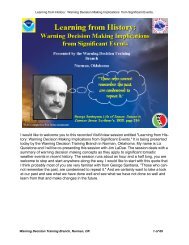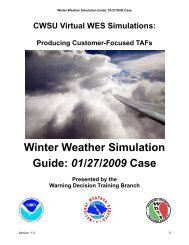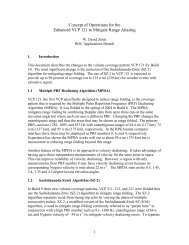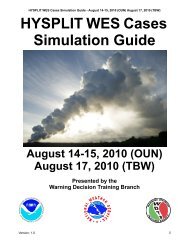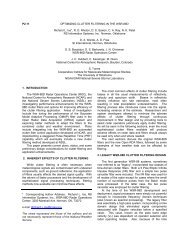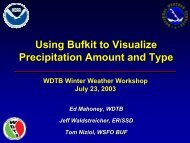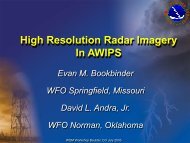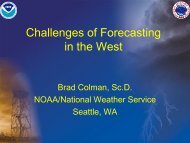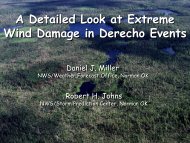Microclimate of the New Jersey Pine Barrens
Microclimate of the New Jersey Pine Barrens
Microclimate of the New Jersey Pine Barrens
You also want an ePaper? Increase the reach of your titles
YUMPU automatically turns print PDFs into web optimized ePapers that Google loves.
IC 4.3: AWOC Winter <strong>Microclimate</strong> Exercise<br />
<strong>Microclimate</strong> <strong>of</strong> <strong>the</strong> <strong>New</strong> <strong>Jersey</strong> <strong>Pine</strong> <strong>Barrens</strong><br />
Greg Heavener, WFO Mt. Holly<br />
May 2011<br />
Overview: There is an area about 30 miles to <strong>the</strong> east <strong>of</strong> Philadelphia that encompasses nearly<br />
seven different sou<strong>the</strong>ast <strong>New</strong> <strong>Jersey</strong> counties. A place where a mythical creature may live and a<br />
pr<strong>of</strong>essional hockey teams garners its name…I am speaking <strong>of</strong> <strong>the</strong> <strong>New</strong> <strong>Jersey</strong> Devil and <strong>the</strong><br />
<strong>New</strong> <strong>Jersey</strong> <strong>Pine</strong> <strong>Barrens</strong>. This write-up is not about <strong>the</strong> Devil, although that would be pretty<br />
cool, but ra<strong>the</strong>r this is about a sometimes large nocturnal temperature gradient that exists<br />
between <strong>the</strong> <strong>Barrens</strong> and surrounding areas. Fig 1 below shows an outline <strong>of</strong> <strong>the</strong> <strong>Pine</strong> <strong>Barrens</strong>.<br />
Due to <strong>the</strong> type <strong>of</strong> sandy and loam soil <strong>the</strong> region has, clear<br />
skies and light winds are very conducive to an increased<br />
radiational cooling effect when compared to surrounding<br />
sites. The lack <strong>of</strong> urbanization coupled with a sparse<br />
population within <strong>the</strong> <strong>Pine</strong> <strong>Barrens</strong> fur<strong>the</strong>r accentuates any<br />
nocturnal radiational cooling effects. There are also very<br />
few observation stations within <strong>the</strong> <strong>Pine</strong> <strong>Barrens</strong> to truly try<br />
to determine an average temperature difference compared<br />
to surrounding areas. This makes temperature forecasting<br />
within <strong>the</strong> <strong>Pine</strong> <strong>Barrens</strong> a little tougher.<br />
Figure 1, map outline <strong>of</strong> <strong>the</strong> <strong>New</strong><br />
<strong>Jersey</strong> <strong>Pine</strong> <strong>Barrens</strong>.<br />
Synoptic-scale Ingredients: It has been seen time and<br />
time again that forecasters should account for large<br />
temperature differences when a ridge <strong>of</strong> high pressure<br />
overhead allows winds to remain calm and skies to clear.<br />
With <strong>the</strong> ridge <strong>of</strong> high pressure axis directly overhead<br />
temperatures in <strong>the</strong> <strong>Pine</strong> <strong>Barrens</strong> can be ten degrees colder<br />
than <strong>the</strong> surrounding areas. Even with a few clouds above<br />
and a light wind temperature differences range between<br />
four to five degrees colder. See figure 2, an image <strong>of</strong><br />
MODIS data on a clear, calm night over <strong>the</strong> <strong>Pine</strong> <strong>Barrens</strong>.<br />
Some MesoNet observations are overlayed on <strong>the</strong> image.<br />
Diagnosis and Prognosis: With high pressure nearing <strong>the</strong> region or directly overhead,<br />
forecasters should be cognizant <strong>of</strong> enhanced radiational cooling within <strong>the</strong> <strong>Pine</strong> <strong>Barrens</strong> region.<br />
The best GFE tool to use would be to use <strong>the</strong> „Make and Edit Area‟ button to highlight <strong>the</strong> <strong>Pine</strong><br />
<strong>Barrens</strong> and <strong>the</strong>n using <strong>the</strong> „Adjust Temp Down‟ or „Assign Value‟ tool to place <strong>the</strong> “correct”<br />
forecasted temperature. Differences <strong>of</strong> ten degrees have been seen when a fresh snow has fallen,<br />
but more times than not, a six to eight degree difference is more likely.
IC 4.3: AWOC Winter <strong>Microclimate</strong> Exercise<br />
Figure 2, MODIS imagery showing an area <strong>of</strong> enhanced cooling over <strong>the</strong> <strong>Pine</strong> <strong>Barrens</strong>, with a temperature<br />
overlay.



